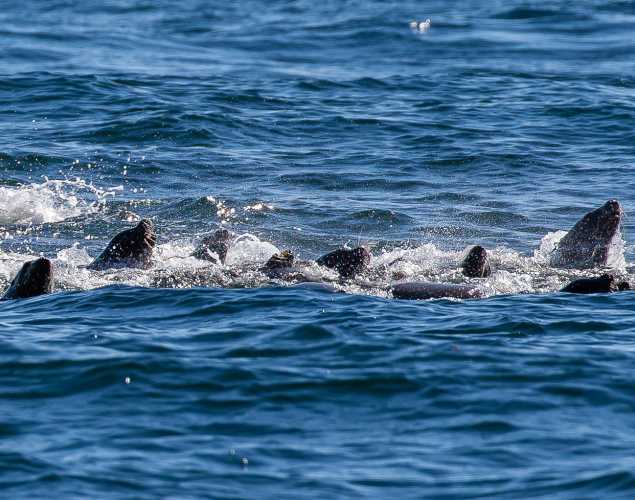
Detecting the Spread of Leptospirosis Through Asymptomatic Carriers
- Leptospirosis
Abstract
Identifying mechanisms driving pathogen persistence is a vital component of wildlife disease ecology and control. Asymptomatic, chronically infected individuals are an oft-cited potential reservoir of infection, but demonstrations of the importance of chronic shedding to pathogen persistence at the population-level remain scarce. Studying chronic shedding using commonly collected disease data is hampered by numerous challenges, including short-term surveillance that focuses on single epidemics and acutely ill individuals, the subtle dynamical influence of chronic shedding relative to more obvious epidemic drivers, and poor ability to differentiate between the effects of population prevalence of chronic shedding vs. intensity and duration of chronic shedding in individuals. We use chronic shedding of Leptospira interrogans serovar Pomona in California sea lions (Zalophus californianus) as a case study to illustrate how these challenges can be addressed. Using leptospirosis-induced strands as a measure of disease incidence, we fit models with and without chronic shedding, and with different seasonal drivers, to determine the time-scale over which chronic shedding is detectable and the interactions between chronic shedding and seasonal drivers needed to explain persistence and outbreak patterns. Chronic shedding can enable persistence of L. interrogans within the sea lion population. However, the importance of chronic shedding was only apparent when surveillance data included at least two outbreaks and the intervening inter-epidemic trough during which fadeout of transmission was most likely. Seasonal transmission, as opposed to seasonal recruitment of susceptibles, was the dominant driver of seasonality in this system, and both seasonal factors had limited impact on long-term pathogen persistence. We show that the temporal extent of surveillance data can have a dramatic impact on inferences about population processes, where the failure to identify both short- and long-term ecological drivers can have cascading impacts on understanding higher order ecological phenomena, such as pathogen persistence.
Buhnerkempe, M.G., Prager, K.C., Strelioff, C.C., Greig, D.J., Laake, J.L., Melin, S.R., DeLong, R.L., Gulland, F.M.D., Lloyd-Smith, J.O. 2017. Detecting signals of chronic shedding to explain pathogen persistence: Leptospira interrogans in California sea lions. Journal of Animal Ecology. 86: 460-472.
Related Publications
{"image":"\/Animals\/Patients\/California sea lions\/cropped-images\/csl-by-bill-hunnewell-c-the-marine-mammal-center-7-0-1446-2827-2208-1603918668.jpg","alt":"California sea lion on pool ledge","title":"Effectiveness of Antibiotics in Treating Leptospirosis in California Sea Lions","link_url":"https:\/\/www.marinemammalcenter.org\/publications\/effectiveness-of-antibiotics-in-treating-leptospirosis-in-california-sea-lions","label":"Research Paper"}

Effectiveness of Antibiotics in Treating Leptospirosis in California Sea Lions
Read More{"image":"\/Animals\/Patients\/California sea lions\/cropped-images\/csl-by-bill-hunnewell-c-the-marine-mammal-center-5-0-1-3112-2431-1603919011.jpg","alt":"California sea lion diving into a pool","title":"First Report of Asymptomatic Carrier Transmission of Leptospirosis","link_url":"https:\/\/www.marinemammalcenter.org\/publications\/first-report-of-asymptomatic-carrier-transmission-of-leptospirosis","label":"Research Paper"}

{"image":"\/Animals\/Wild\/California sea lion\/cropped-images\/sea-lions-underwater-baja-shutterstock-186-4-4173-3260-1603919420.jpg","alt":"California sea lions underwater","title":"Seasonal Migration Contributes to Spread of Leptospirosis","link_url":"https:\/\/www.marinemammalcenter.org\/publications\/seasonal-migration-contributes-to-spread-of-leptospirosis","label":"Research Paper"}

{"image":"\/Animals\/Patients\/California sea lions\/cropped-images\/csl-eating-by-bill-hunnewell-c-the-marine-mammal-center-0-361-1799-1405-1617816863.jpg","alt":"California sea lion eating a fish","title":"Predicting Prognosis in Wildlife Rehabilitation: A Case Study of Leptospirosis in Sea Lions","link_url":"https:\/\/www.marinemammalcenter.org\/publications\/predicting-prognosis-in-wildlife-rehabilitation-a-case-study-of-leptospirosis","label":"Research Paper"}

Predicting Prognosis in Wildlife Rehabilitation: A Case Study of Leptospirosis in Sea Lions
Read MoreRelated News
{"image":"\/Animals\/Wild\/Humpback whale\/cropped-images\/humpback-whale-sea-lions-photo-c-bill-hunnewell-102-0-1270-992-1743014972.jpg","alt":"A California sea lion jumps out of the ocean next to a humpback whale showing its tail and another whale showing its back.","title":"What is the Loudest Animal on Earth? And Other Animal Trivia","link_url":"https:\/\/www.marinemammalcenter.org\/news\/what-is-the-loudest-animal-on-earth-and-other-animal-trivia","label":"News Update","date":"2025-03-26 07:00:00"}

{"image":"\/Animals\/Patients\/California sea lions\/2024\/csl-autumn-photo-by-chris-deimler-c-the-marine-mammal-center.jpg","alt":"A California sea lion with a small satellite tag on its back walks on a rocky beach toward the ocean.","title":"From Treating Sick Sea Lions to Tracking Them in the Wild: Follow Autumn","link_url":"https:\/\/www.marinemammalcenter.org\/news\/from-treating-sick-sea-lions-to-tracking-them-in-the-wild-follow-autumn","label":"Patient Update","date":"2025-02-27 15:23:46"}

From Treating Sick Sea Lions to Tracking Them in the Wild: Follow Autumn
February 27, 2025
Read More{"image":"\/Misc\/cropped-images\/leashed-dog-on-beach-shutterstock-10-10-5572-4352-1696014237.jpg","alt":"a golden retriever lying on a sandy beach with a leash and harness","title":"How to Keep Your Dog Safe on Beaches","link_url":"https:\/\/www.marinemammalcenter.org\/news\/how-to-keep-your-dog-safe-on-beaches","label":"News Update","date":"2023-09-29 02:00:00"}

{"image":"\/Animals\/Patients\/Rescues\/cropped-images\/csl-grazer-pre-rescue-photo-c-the-marine-mammal-center-515-229-784-612-1694454282.jpg","alt":"California sea lion on a sandy beach with flippers tucked to abdomen","title":"San Francisco Chronicle: Why Sick Sea Lions are Washing Up on the California Coast","link_url":"https:\/\/www.marinemammalcenter.org\/news\/san-francisco-chronicle-why-sick-sea-lions-are-washing-up-on-the-california-coast","label":"In the News","date":"2023-09-09 02:00:00"}

San Francisco Chronicle: Why Sick Sea Lions are Washing Up on the California Coast
September 9, 2023
Read More